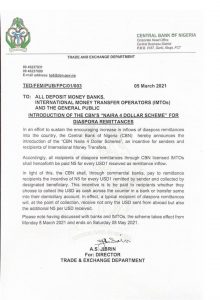The Central Bank of Nigeria (CBN) has announced a program to encourage international remittances and encourage the use of official corridors to retrieve funds. The CBN’s move to incentivize recipients follows the decline in the country’s official remittance inflows as recipients opt for nontraditional corridors like cryptocurrencies.
Declining transfers
Under the CBN’s “naira-for-dollar” system, recipients of international transfers are entitled to an additional payment of 1.2 cents (5 naira) for every US dollar received. According to the CBN, however, this incentive system should only last 60 days.
With the announcement of these new measures, the CBN aims to “increase the inflow of diaspora remittances into the country”. In a letter explaining how the incentive system works, the central bank said:
With this in mind, the CBN pays the commercial banks to remittance recipients the incentive of 5 naira for every USD 1 transferred from the sender and withdrawn from the designated beneficiary. This incentive is paid to recipients whether they want to collect the USD as cash over the counter or transfer it to their domicile account.
According to the letter, the incentive system is due to end on May 8, and officials are confident that this will encourage the flow of remittances into the country through the banking ecosystem.
Immerse yourself in incoming transfers
As previously reported by news.Bitcoin.com, Nigeria’s international remittance inflows fell towards the end of 2020. As data from Nairalytics shows, the country’s inflows fell from a high of $ 2.05 billion in January 2020 to $ 54.4 million by the end of September 2020.
Overvalued exchange rate
The massive decline in remittances through official corridors is due to the fact that more Nigerians switched to companies that use cryptocurrencies when moving funds across borders. Unlike regulated financial institutions that use the “official exchange rate,” the increasingly popular crypto remittance companies reportedly (before the policy was introduced) used the parallel exchange rate when converting USD to naira. As the gap between the official and parallel exchange rates widened, inflows through official channels decreased, while the volumes processed by crypto companies increased.
Meanwhile, the CBN has devalued the naira currency three times in its previous attempts to stem the decline in foreign exchange inflows. The first devaluation was announced in March 2020 when the dollar to naira exchange rate rose from 1: 307 to 1: 360. Four months later, the rate was adjusted slightly to USD 1 for 380 nairas. On its last devaluation, the CBN raised the exchange rate for 411 nairas to USD1. According to Abokifx, a website that tracks the parallel market exchange rate, one US dollar was trading for 475 nairas at the time of writing. It remains to be seen whether the incentive system will succeed in bringing remittance inflows back to the previous level.
What do you think of the CBN incentive system? Let us know what you think in the comments section below.
Photo credit: Shutterstock, Pixabay, Wiki Commons

